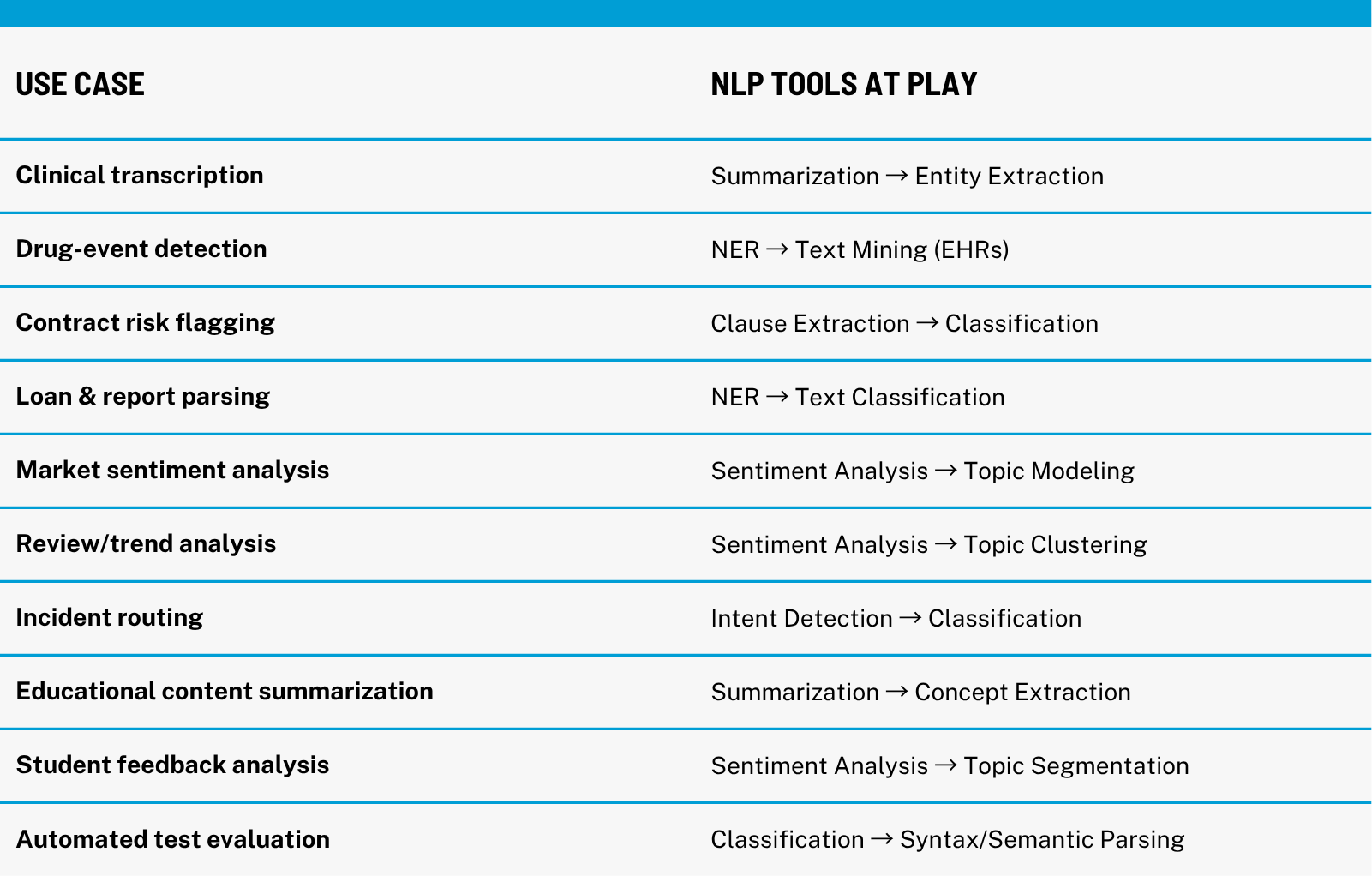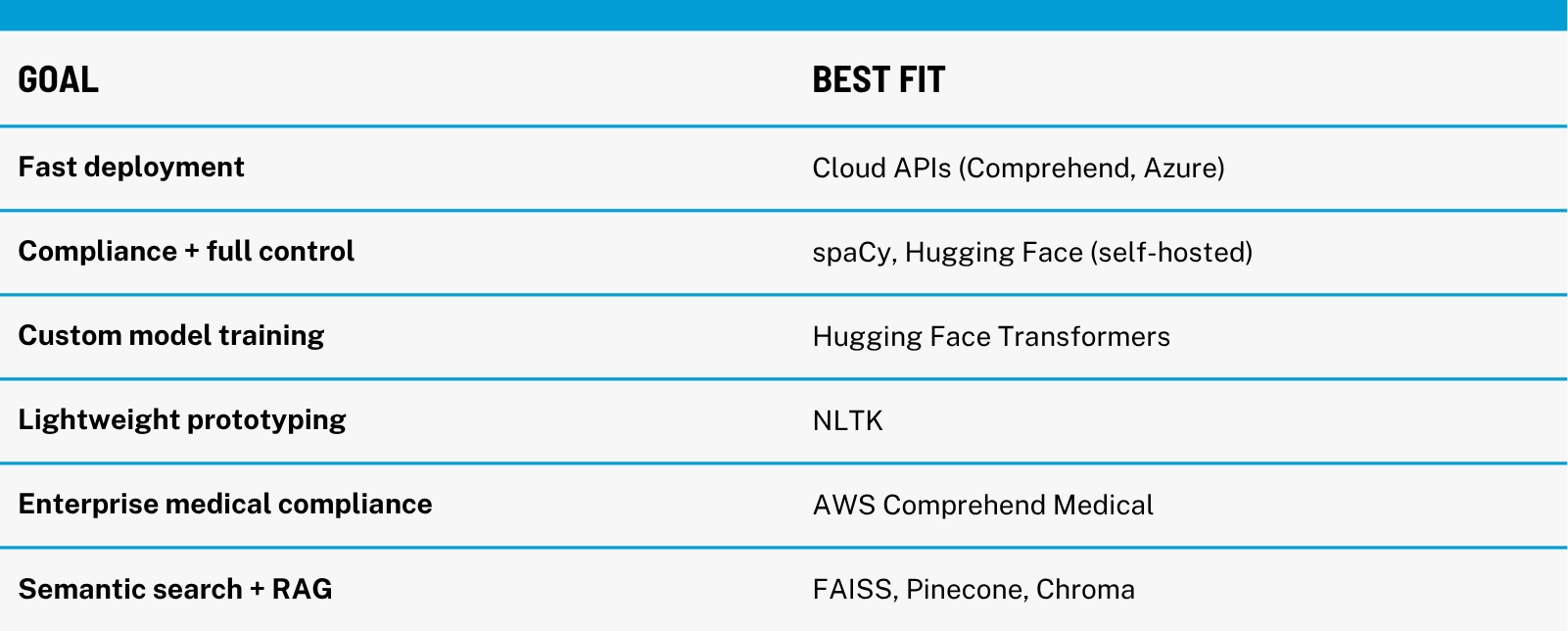Natural Language Processing (NLP) has become one of the most widely discussed branches of AI; however, the conversation often begins and ends with chatbots.
While conversational AI has its place, it barely scratches the surface of what NLP-based software can do in real business contexts. Behind the scenes, NLP is driving far more impactful outcomes: from parsing legal clauses and extracting insight from customer reviews to structuring massive volumes of free-form data in healthcare, finance, and logistics.
According to market forecasts, the global NLP sector is expected to grow from $29.7 billion in 2024 to over $158 billion by 2032, with an annual growth rate exceeding 23%. Even back in 2022, among companies already using NLP, 77% planned to increase their investment, reflecting strong trust in its business value. And now we’re seeing the results of these investments.
In this article, we explore how NLP is being applied far beyond the help desk, highlighting core capabilities, real use cases across industries, technical workflows, tools, challenges, and measurable business benefits. Thinking of NLP as purely a tool for chatbots is an almost guaranteed way to miss out on the vast majority of its impact and benefits.
What NLP Really Covers
Natural Language Processing (NLP) includes a spectrum of capabilities far broader than chatbot responses. These building blocks empower systems to process, understand, and react to language in diverse ways.
Core NLP Capabilities
- Named Entity Recognition (NER). Identifies and categorizes key terms like people, organizations, dates, locations, and more within text. It converts freeform text into structured data, powering roles like contract analysis, content tagging, and knowledge graph creation.
- Text Classification & Topic Modeling. Automatically categorizes documents by topic or purpose. This facilitates content organization, sentiment segmentation, and routing workflows.
- Sentiment Analysis. Detects emotional tone (positive, negative, or neutral) within text. Widely used in customer feedback analysis, brand monitoring, and even clinical research.
- Summarization & Text Generation. Distills lengthy documents into concise summaries, extracting core ideas without losing meaning. Common in legal briefs, executive summaries, and news reports.
- Language Detection & Translation. Detects language automatically and supports translation workflows, essential for global content handling and multilingual support systems
How They Fit Together
Each piece can stand alone or integrate with others to build more powerful workflows:
- NER can feed structured entities into classification systems.
- Sentiment analysis informs routing in customer support pipelines.
- Summarization complements extraction tools to present clean, concise insights.
- Language detection triggers translation workflows or language-specific processing.
For businesses, the true power of NLP lies in turning messy, unstructured text into structured insight. It enables faster, more accurate extraction of critical data from contracts, reports, and customer interactions, reducing the need for manual review. Teams can move beyond keyword searches and gain a deeper understanding of user sentiment, intent, and urgency, helping them respond faster and with more context.
Whether automating summaries for research, parsing multilingual content, or classifying incoming tickets in real time, NLP quietly improves clarity, efficiency, and decision-making across operations. When integrated and deployed well, it becomes an infrastructure in itself.
Industry-Specific Use Cases
Let’s dive into how these NLP capabilities drive impactful outcomes in real-world business settings:
Healthcare
Physician notes, lab reports, and EHR data create tremendous amounts of unstructured text. NLP-powered tools automate transcription, update medical records, and support billing, freeing clinicians to focus on care. Other tools can be embedded into clinical AI software to detect and cross-reference drug interactions, medical history, allergies, and other relevant aspects, providing a comprehensive picture to the practitioner faster and with greater precision.
Education
In EdTech platforms, NLP powers reading comprehension assessments, question generation, and multilingual feedback parsing. Institutions also apply NLP to analyze student feedback at scale, spotting patterns in engagement, confusion, or dropout risks, turning passive data into proactive action.
Legal & Contract Management
Large document repositories become manageable with NLP-powered extraction: entity discovery, clause detection, and risk flagging enable compliance reviews and due diligence to be done at speed. For large law firms and legal departments, this translates into time savings and better risk control.
Finance
NLP helps firms automate repetitive paperwork tasks such as loan approval documentation and financial report parsing, minimizing manual effort and accelerating workflows. Sentiment analysis, particularly FinBERT-style models, also delivers investment insights by evaluating market reports, social media feeds, and earnings calls, often with greater precision than rule-based systems.
Retail & E-Commerce
Beyond chatbots, NLP elevates customer analysis through review insights and automated tagging. Retailers apply sentiment analysis for emerging trend detection, brand perception monitoring, and even voice search. One estimate suggests around one-third of retailers now use NLP for product search and customer feedback, highlighting its value in personalization and intelligence within the industry.
Logistics & Operations
In logistics, NLP interprets free-form data, such as routing notes, incident descriptions, and service emails, turning them into structured inputs for dashboards and automated processes. This helps streamline dispatch systems and accelerate problem-solving workflows

Data Pipelines: Where NLP Fits in the Workflow
NLP is embedded within data pipelines that transform unstructured text into structured, actionable intelligence. These pipelines can operate in real time or batch mode, depending on business needs.
Real-Time vs. Batch Processing
Real-time pipelines handle text as it’s generated, such as incoming emails, support chat, or social media mentions. This setup enables immediate routing, alerting, or analysis with minimal delay. Leveraging real-time processing yields faster decision-making, though it requires more robust architecture and resources.
Batch processing works with accumulated text, executing analyses at predetermined intervals, common in report generation, end-of-day financial summaries or monthly survey reviews. It supports high-volume text efficiently, though with inherent latency.
Many enterprises combine both in a lambda architecture, using real-time systems for immediate response and batch systems for deeper analytics and compliance readiness .
Sample Pipeline
- Ingestion: Capture text via APIs or file drops.
- Preprocessing: Normalize text, detect language, translate if needed.
- Feature/Embedding Generation: Use transformers for semantic understanding.
- Model Inference: Apply classification, NER, sentiment analysis as needed.
- Post-Processing: Map outputs to system workflows or extract structured data.
- Routing/Storage: Push results into CRMs, support queues, and analytics dashboards.
- Feedback Loop: Human review and corrections feed back into model retraining.
Popular NLP Tools, Frameworks & APIs
NLP projects range from lightweight integrations to scale-critical pipelines. Choosing the right tools is key, whether you prioritize speed, customization, compliance, or everything at once.
Open-Source Libraries
- spaCy offers fast, production-ready NLP pipelines for tasks like NER, part-of-speech tagging, and dependency parsing. It’s easy to integrate into Python applications and highly extensible.
- Hugging Face Transformers provides access to pre-trained state-of-the-art models (BERT, GPT, T5), which you can fine-tune on specific datasets. This flexibility supports complex needs like summarization, classification, and question answering .
- NLTK remains a strong toolkit for education, prototyping, and light text manipulation, offering tokenization, stemming, and basic classification functionality
Cloud NLP APIs
- Amazon Comprehend bundles NER, sentiment analysis, language detection, and key phrase extraction into a managed service, which can be ideal for teams that want turnkey performance with minimal setup.
- AWS Comprehend Medical further enables secure and compliant extraction of clinical entities like anatomy, medications, and PHI, supporting HIPAA-regulated healthcare use cases.
- Google Cloud NLP & Azure Text Analytics offer comparable capabilities via REST APIs, with strong support for multiple languages and regional compliance needs.
Vector Databases & Semantic Search
Tools like ChromaDB, Milvus, Pinecone, and FAISS store and search vector embeddings—numeric representations of text or documents. These enable semantic search and power RAG (Retrieval Augmented Generation) workflows often used alongside LLMs. Vector search goes beyond keyword matching to capture meaning and intent, enabling smarter retrieval and recommendations.
Choosing The Approach
If your goal is rapid deployment with minimal maintenance, cloud APIs or spaCy provide great starting points. When you need high accuracy, domain specialization, or embedding LLM context, investing in Hugging Face fine-tuning and vector databases offers deeper control and flexibility, but requires more engineering capacity. Companies with NLP development expertise can help you navigate the path towards choosing the right technology that would fit your objectives, existing infrastructure, business context, and other important factors.

Challenges to Consider
Building NLP-powered business solutions brings significant benefits, but also real-world hurdles. Understanding these challenges upfront helps plan for sustainable and effective implementation.
Domain Expertise vs. Out-of-the-Box Models
Cloud APIs and general-purpose libraries work well for common languages and mainstream terminology. But in specialized domains like legal contracts, medical diagnostics, or financial reporting, models often miss context or mislabel terms. Customizing or fine-tuning is essential but demands labeled data, domain-specific expertise, and development resources.
Multilingual & Low-Resource Language Support
Handling multiple languages is more than translation. Models must detect language, standardize text, and process cultural nuances. Many tools have strong support for English and well-resourced languages, but performance can degrade in underrepresented or low-resource languages, leading to lower accuracy and bias.
Ambiguity & Contextual Interpretation
Human language is inherently ambiguous. Words, phrases, and sentiments can shift meaning depending on context, sometimes subtly. Even high-quality models can misinterpret sarcasm, humor, or domain-specific jargon. Techniques like contextual embeddings help, but they’re not foolproof and often need iterative tuning.
Data Privacy & Model Compliance
NLP systems frequently process sensitive data like contracts, emails, and medical records. Organizations must carefully consider where processing occurs (on-premise or in cloud), and how transcripts, embeddings, and textual outputs are stored, encrypted, or purged to comply with HIPAA, GDPR, or other industry- or location-specific regulations.
Latency & Integration in Production
Embedding NLP in live workflows requires attention to speed and scale. Real-time use demands response times under one second; batch systems need to run efficiently on large datasets. Integrating robust AI tools like NLP results into CRMs, ERPs, and reporting systems requires robust APIs, orchestration tools, and monitoring.
Model Drift & Maintenance
Language evolves, and business contexts change. Models that served well initially can degrade over time, introducing errors or bias. Continuous evaluation, periodic retraining, and monitoring are crucial to maintain reliability and relevance in production.
Human-in-the-Loop & Governance
Even automated systems need guardrails. Low-confidence predictions, ambiguous classifications, or flagged content should enter review queues. Effective NLP pipelines include feedback loops that capture corrections and refine model performance over time, but these workflows require governance, process alignment, and cultural buy-in.
The Takeaway
Across industries, businesses are using NLP to extract insights, automate decisions, and bring structure to the thousands of documents, emails, and messages that flow through their systems every day. What used to require hours of manual review can now happen in real time, with great accuracy.
The opportunity lies in how well NLP is embedded into your workflows. It’s not about building flashy AI—it’s about solving real bottlenecks and surfacing the right information at the right moment.
If you’re exploring how custom NLP-powered solutions can support your operations, research, or digital product, we can help you make that capability real through strategy, implementation, and long-term support.